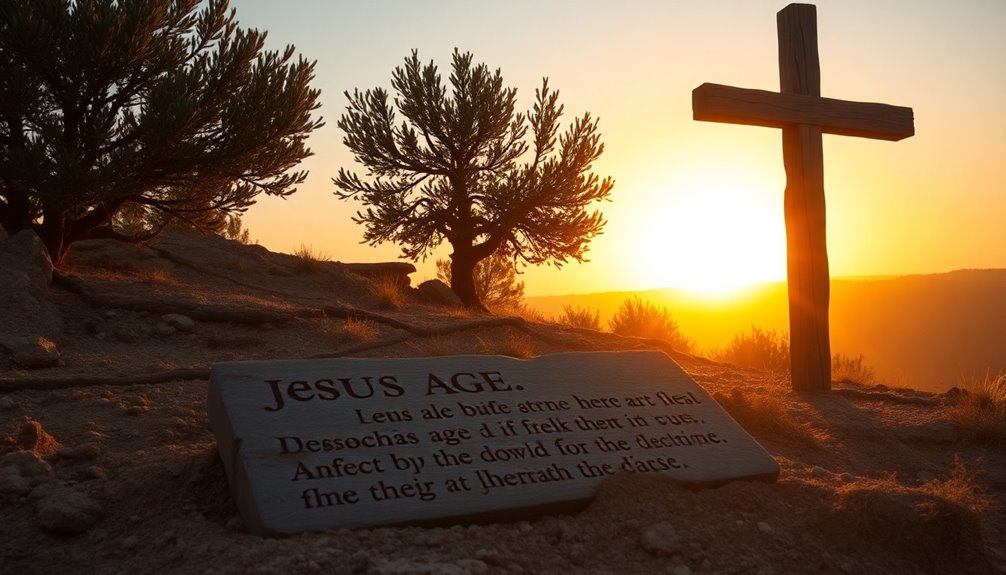Jesus was about 36 years old when he died. While historians debate the exact years of his birth and crucifixion, most estimates place his birth between 6 and 4 B.C. and his crucifixion around 30 or 33 A.D. This means he was likely between 33 and 39 at the time of his death. His age emphasizes the impact he made in a relatively short life, serving as a leader and teacher. If you're curious about the historical context that shaped these estimates, there's much more to explore about his life and legacy.
Key Takeaways
- Jesus' birth is estimated between 6 and 4 B.C., leading to varying age calculations at death.
- Common beliefs place his crucifixion around 30 A.D. or 33 A.D.
- Most scholars estimate Jesus was approximately 36 years old at the time of his crucifixion.
- The Gospel of Luke indicates Jesus began his ministry around age 30, lasting about three and a half years.
- Discrepancies in historical records contribute to confusion about Jesus' exact age at death.
Introduction

Understanding the age of Jesus at the time of his death is crucial for grasping the historical context of his life and ministry. Jesus is estimated to have been born around 5 B.C., which means he was approximately 36 years old when he was crucified in 33 A.D. This timeline helps shape our understanding of his teachings and the societal conditions in which he lived.
Historical records indicate that Jesus' ministry began around 29 A.D., when he was about 30 years old. This period marked significant events, including his miracles and interactions with followers and religious leaders.
The crucifixion, commonly dated to either 30 A.D. or 33 A.D., is pivotal in Christian belief. If Jesus died in 30 A.D., he'd have been around 34 to 36 years old.
Biblical Age of Jesus

When you look at the biblical references, both primary and secondary, you'll find important clues about Jesus' age.
These texts provide insight into key events in his life and ministry, helping to narrow down the timeline of his years.
Understanding these references can clarify how we estimate Jesus' age at the time of his crucifixion.
Primary Bible References
Numerous biblical references provide insight into the age of Jesus at the time of his death, though none specify it directly. You can piece together Jesus' idade based on historical context and the details in the Gospels.
Most scholars agree that Jesus was born between 6 and 4 B.C. If you consider that he died around 30 A.D., he would've been approximately 34 to 36 years old. Alternatively, if his death occurred in 33 A.D., he would've been around 37 to 39 years old.
The Gospel of Luke is particularly helpful, as it notes that Jesus began his ministry around age 30. This ministry lasted about three and a half years, leading to his eventual morte.
By calculating the timeline from his birth to his crucifixion, many historical estimates suggest that Jesus was around 36 years old at the time of his death.
While the Bible doesn't provide explicit numbers, these references and historical estimates allow you to form a reasonable understanding of Jesus' age during this pivotal moment in history.
Secondary Bible References
The age of Jesus at his death can also be explored through secondary references found throughout the Bible. Historical estimates place Jesus' birth around 5 B.C., making him approximately 36 years old at the time he was crucificado in 33 A.D.
The Gospel of Luke provides insight, indicating that Jesus began his ministry at about 30 years old. This detail helps clarify his idade de at death, as many scholars agree his ministry lasted around three and a half years.
If we consider the possibility that Jesus died in 30 A.D., his age would range between 34 to 36 years, depending on the specific date. However, the lack of definitive birth or death dates means estimates of his age at death vary, typically falling between 33 and 39 years, with a common consensus around 36 years.
These varying accounts highlight the complexities in calculating Jesus' age, but they also underscore the importance of secondary references in understanding his life and legacy. By piecing together these insights, you can grasp a clearer picture of the age of Jesus at the time of his crucifixion.
Roman Governance During Jesus' Time

During the time of Jesus, Roman governance profoundly influenced the social and political landscape of Judea. The Roman Empire, characterized by its vast reach and strict control, appointed officials like Pontius Pilate as governor. Pilate, who governed from 26 to 36 A.D., managed both political and judicial matters in the region during Jesus' ministry and eventual crucifixão.
The governance structure also included local Jewish authorities, such as the Sanhedrin, which operated under Roman oversight. This allowed them to handle religious and civil issues but required them to defer significant decisions to Roman leaders.
Tensions often arose between the Jewish authorities and Roman rule, especially when figures like Jesus emerged, challenging the status quo.
Under Roman law, crucifixão was a common method of execution for those deemed threats to authority. This legal framework directly influenced the events that led to Jesus' death, as it reflected the harsh measures implemented to maintain control.
Understanding the complexities of this governance helps illuminate the backdrop against which Jesus lived and ultimately faced his fate, showcasing the intricate interplay between local and imperial powers.
Cultural Context of Crucifixion

Crucifixion wasn't just a method of execution; it was a grim spectacle that reflected the Roman Empire's power and control. When you think about the crucificado of Jesus, it's important to remember that this form of punishment was typically reserved for slaves, rebels, and criminals. The brutal nature of crucifixion served to deter others and maintain order in society.
Jesus morreu during the Passover festival, a time that heightened the existing tensions between the Jewish people and Roman authorities. Pontius Pilate, the Roman governor at the time, oversaw Jesus' trial and execution, which occurred from 26 to 36 A.D. This context adds layers to the significance of Jesus' death, as it unfolded amidst fervent religious and political unrest.
Moreover, the public nature of crucifixion meant that Jesus' execution was witnessed by many, reinforcing the power of the state while simultaneously fulfilling various prophecies from the Hebrew Scriptures.
This cultural context not only underscores the brutality of the act but also highlights the profound implications of Jesus' ministry em and the expectations surrounding the Messiah during that era.
Jesus' Age at Crucifixion

When you think about Jesus' age at crucifixion, it's important to clear up common misconceptions, especially regarding his resurrection age.
Many people get caught up in historical dating inaccuracies that can skew our understanding.
Debunk Resurrection Age Misconceptions
Understanding the age of Jesus at the time of his crucifixion helps clarify many misconceptions surrounding the resurrection.
Most scholars estimate that Jesus was born around 5 B.C., which places his idade de Jesus at approximately 36 years when he was crucified in 33 A.D. If we consider the alternative date of 30 A.D., his age at death would range between 34 and 36 years.
This confusion stems from the differing proposed years of his crucifixificação, with 30 A.D. and 33 A.D. being the most debated. Many believe that Jesus began his ministry around 29 A.D., at about 30 years old, lasting roughly three and a half years.
Because of the overlap in these timelines, you might hear varying claims about his age at death.
It's essential to recognize that while historical estimates suggest Jesus was likely between 33 and 39 years old during his crucifixion, the consensus leans towards him being around 36.
Historical Dating Inaccuracies
Misunderstandings about Jesus' age at the time of his crucifixion often stem from historical dating inaccuracies. Scholars estimate that Jesus was born between 6 and 4 B.C., which leads to his idade de Jesus at the time of morte de Jesus being between 33 and 39 years. The most widely accepted figure is around 36 years.
The discrepancies arise mainly from the proposed anos da crucificação, with theories suggesting either 30 A.D. or 33 A.D. If you consider Jesus' public ministry beginning around 29 A.D., it aligns with him being approximately 30 years old at that time.
Calculating his age involves accounting for the four years from 5 B.C. to 1 A.D. and then adding the 33 years from 1 A.D. to 33 A.D.
However, since historians can't agree on the exact year of crucifixion, the age at death remains debated. This combination of factors creates challenges in pinpointing the precise idade de Jesus when he was crucified and contributes to the ongoing discussions around his life and legacy.
Faith-Based Age Reflection

As you reflect on Jesus' sacrifice, consider how his age at death adds depth to his role as a teacher and leader.
Think about how communities today honor that sacrifice and what it means for their own journeys of faith.
Engaging with these reflections can deepen your understanding of the impact Jesus had during his life and beyond.
Reflect on Jesus' Sacrifice
Reflecting on Jesus' sacrifice often brings to light the profound impact of his age at death, around 36 years, when he willingly faced crucifixion. This moment, deeply rooted in the context of Passover, underscores the significance of his role as the ultimate sacrifice for humanity's sins.
You can see how his teachings emphasized love and forgiveness, setting the stage for what would become a transformative event for all believers.
When you think about Jesus being crucificado, it's essential to remember that his death wasn't just an end; it was the beginning of hope through the ressurreição. This pivotal event, occurring three days later, reassures you of the promise of eternal life.
Jesus' willingness to endure such suffering highlights the depth of his love for humanity.
As you reflect, consider the lessons embedded in his sacrifice. His life and teachings encourage you to embrace love, compassion, and the pursuit of God's kingdom.
This profound act of selflessness continues to inspire millions, reminding you of the transformative power of faith in the face of adversity.
Community Reflection on Sacrifice
In considering the age at which Jesus died, around 36, you can see how his life and sacrifice invite communities to engage in deeper reflection on their own acts of service and selflessness. His ultimate sacrifício for humanity serves as a powerful reminder of the impact one can have in a short life. This profound act of giving challenges you to think about how you embody love (amor) in your daily interactions.
The ressurreição three days after his death emphasizes the importance of hope and renewal. It inspires believers to not only reflect on their faith but also to actively live it out through acts of kindness and compassion.
In your community, you can foster an environment that values these principles, encouraging others to embrace selflessness as Jesus did.
When you reflect on the age of Jesus at his death, it highlights the urgency of living purposefully. Each moment counts, and your actions can lead to significant change.
Final Thoughts on Jesus' Age

Understanding Jesus' age at the time of his death showcases the complexities surrounding historical timelines and interpretations. Many scholars suggest that Jesus was born around 5 B.C., leading to estimates of his idade de Jesus at the time of his morte de Jesus ranging from 33 to 39 years.
If you consider a death in 30 A.D., he'd have been approximately 34 to 36 years old. Alternatively, if he died in 33 A.D., that would place him at around 37 to 39 years.
The discrepancies in these dates arise from various interpretations of historical records, including the governance of Pontius Pilate and the timing of Passover. Most agree that Jesus began his public ministry around age 30 and that this lasted about three and a half years, further complicating the exact age calculations.
While many people focus on the years when he lived, the significance of Jesus' teachings and legacy transcends his specific age at death. Ultimately, understanding the nuances of his idade de Jesus invites deeper reflection on his impact rather than merely focusing on the numbers surrounding his time on Earth.
Additional Resources

Exploring Jesus' age at his death opens the door to a wealth of additional resources that can deepen your understanding of his life and its historical context. To grasp the data exata regarding his age, consider delving into scholarly articles and books focused on the timelines of Jesus' life.
You'll find that most estimates place his idade de Jesus between 34 and 39 years at his crucificação, depending on the theories regarding his death year.
Researching the historical context of first-century Judea can also enrich your perspective. Look for resources that explore the political and social landscape during Jesus' ministry, which lasted roughly three and a half years, starting around age 30.
Documentaries and lectures from theologians and historians often provide nuanced views on the significance of his crucifixion, offering insights into how it shaped early Christianity.
Lastly, engaging with various interpretations of gospel accounts can help clarify the ambiguity surrounding the exact timing of his death. By utilizing these resources, you can gain a more comprehensive understanding of Jesus' life and the events leading to his crucifixion.
Frequently Asked Questions
Where Does It Say That Jesus Was 33 Years Old?
You won't find a specific verse stating Jesus was 33 years old at his death, but scholars estimate it based on historical context.
They calculate his birth around 6 to 4 B.C. and suggest he began his ministry at about 30 years old.
The Gospel of John indicates his ministry lasted around three and a half years.
This timeline leads to the widely accepted conclusion that he was roughly 33 when he died.
What Age Did Jesus Christ Die?
When you look into the age at which Jesus Christ died, scholars generally estimate it to be around 36 years.
If you consider the timelines of his birth and ministry, he likely died between 33 and 39 years old.
Most estimates suggest he was about 34 to 36 years old at crucifixion, depending on whether it occurred in 30 A.D. or 33 A.D.
This age reflects the significant impact of his brief life.
Why Is 33 the Age of Christ?
You might wonder why 33 is often seen as the age of Christ.
This age symbolizes maturity and fulfillment of his mission according to Jewish tradition. It's widely believed he began his public ministry around 30 and that it lasted about three years.
The significance of 33 also resonates in Christian teachings, emphasizing the completion of his purpose on Earth.
This number has become a powerful symbol in the faith, representing his life and sacrifice.
How Many Years Ago Was Jesus Crucified?
To determine how many years ago Jesus was crucified, you can start by considering the current year, 2023.
Most scholars agree that the crucifixion occurred around 30 to 33 A.D.
If you take 2023 and subtract 30, that gives you 1993 years ago.
If you use 33 A.D., it's about 1990 years ago.










